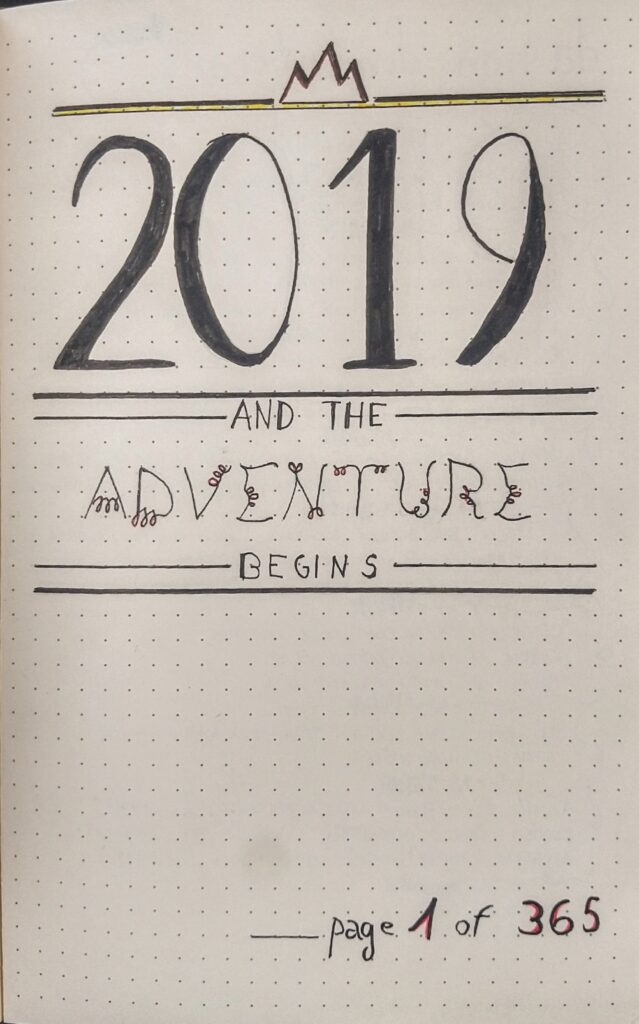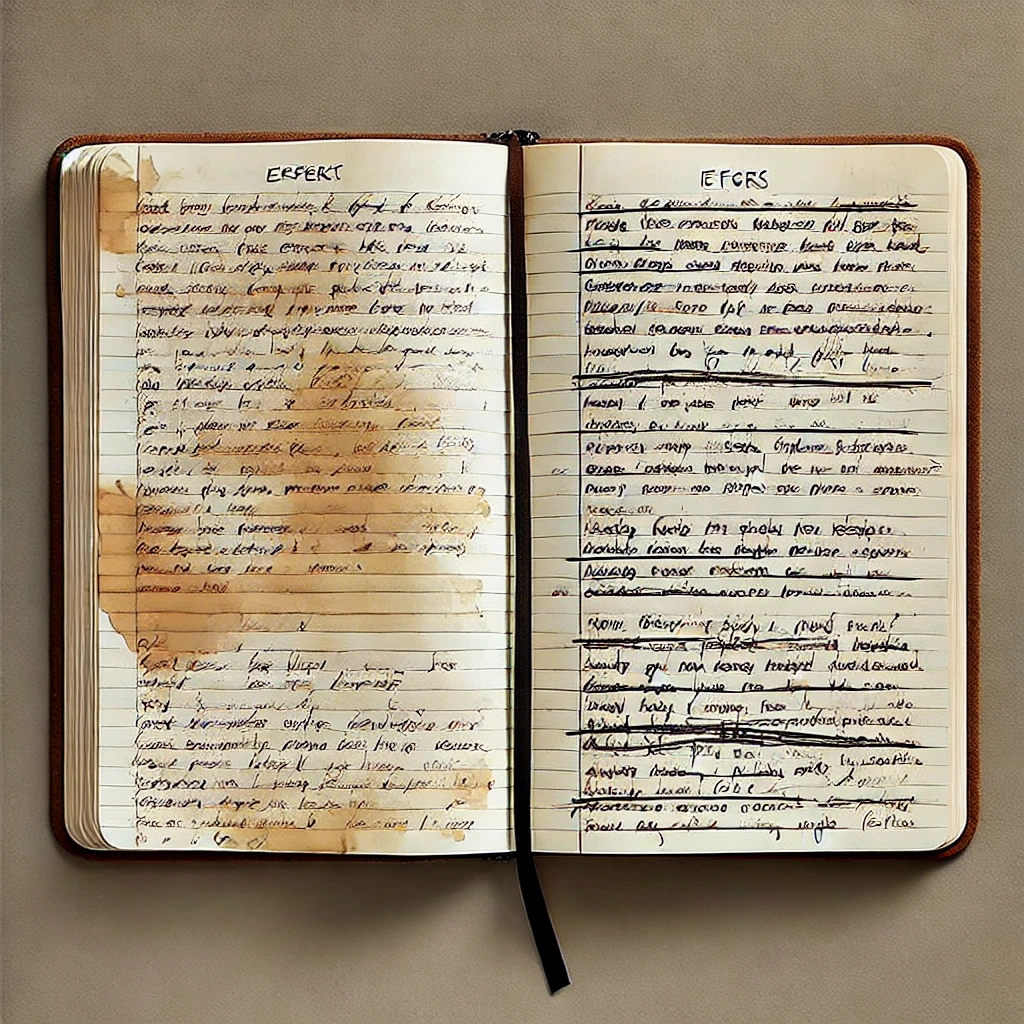
Chapter 1
Journaling starter Kit
for Beginners

Chapter 1:
Introduction to journaling
“Journaling Starter Kit for Beginners”
Welcome to the “Journaling Starter Kit for Beginners” by Journaling Now.
The purpose of this guide is to provide you with a simple and immediate starting point.
Journaling does not have a formal school; there are many ways to journal and many methodological and philosophical approaches. None of these methods is the right or wrong one, and none is the “true way to do journaling.”
What I will illustrate to you in this guide and on this site is my approach and my ways to think about journaling. If you feel it’s not for you, no problem—keep experimenting and exploring. 🙂
This first chapter is very important because it aims to create the right attitude toward your journaling practice.
Before diving into the practice, it’s important to understand journaling better and address any doubts or difficulties you might have, preventing them from arising in the first place!
First of all, there are three fundamental points that I want to introduce to you, the Pillars of Journaling Now:
- Purpose.
Without a defined purpose, you won’t be able to continue your journaling practice. - Flexibility.
The practice of journaling is not set in stone; it evolves with you based on your needs, projects, and life moments. - Personal Growth.
The journaling described in this guide is a personal growth tool and does not focus on the artistic side. Your journal might be “ugly” by general standards, but it will serves your Purpose.

We will address these points later.
Now let’s analyze the most common difficulties, which are also the reasons why people most often abandon journaling.
“Journaling is not for me!”
Maybe you searched online for “journaling” or “Bullet journal” and… you gave up, or you started and then gave up.
I have read hundreds of posts in groups and dedicated pages about the most common problems for a beginner:
- “I want to start a journal, but I don’t know where to begin.”
- “I’m not able to decorate my pages, and my journal looks ugly, so I gave up.”
- “I can’t buy expensive notebooks.”
- “The bullet journal is too complicated.”
- “I don’t have time to journal, I wish I did.”
Let’s break down these difficulties together.
1. Journaling “It’s too complicated.”
It’s not complicated at all, or at least it doesn’t have to be because you tailor your journal practice to your needs.
You absolutely shouldn’t let yourself be influenced by other people’s journals; everyone creates their own personal one.
If you want something simple it will be. I’ve personally used the Bullet journal method for about one year and while I think it’s brilliant and inspired my journaling, it’s not for me, I can’t keep up with it. So I approached journaling in my own way.
2. I don’t have artistic skills!
Personally, I would love to be able to draw, and sometimes I try to include a sketch or two. But I don’t spend too much time on it. It’s more a way to remember places or moments. Also, it’s been years since I’ve decorated my pages—they’re simply black and white and extremely minimalistic.
Unless reaching a certain level of artistic skill is your goal, drawing is not mandatory, and drawing and decorating every single page doesn’t make your journaling more effective. If you want to include some pieces of art you can always print a drawing or a photograph that you like and stick it on the page of your journal.
3. I’m not constant!
You don’t have to write every day if you don’t feel like it, and there’s no rule that obligates you to write for a specific period of time. You can write less, you can write longer. You can skip one day, two days a week.
If you don’t need to, don’t write, if you need to, write several times a day.
Of course there are pages that you may need and therefore you will have to write them down in advance. For example a calendar of sorts, but if you don’t write it when you should, that’s ok!
No pressure—if you’re not consistent, it’s probably because you already have other things on your mind. Adding pressure and stress to a practice that’s supposed to alleviate them is counterproductive.
4. I don’t know what to write.
If you don’t know what to write it’s probably due to a lack of method. By following this guide, I will offer you ideas and a starting point.
Everything depends on the “purpose” you set for your journal. If sometimes you don’t know what to write, that’s perfectly normal. However, if you feel the urge to start a journal, it’s probably for a reason you haven’t fully processed yet and we’ll tackle it together.
5. I don’t have the time.
Probably, when you imagine someone writing in their journal, you picture a person sitting at a perfectly organized desk with a hot cup of tea, incense burning, and perfect solitude while the words effortlessly flow onto the blank pages. Am I right?
Well, now I’m going to shatter this fantasy. More often than not, it will be less then 5/10 minutes where you jot down whatever is necessary, in the form of scribbled comments and lists of things you need to do or want to explore further. Often in a hurry, right before heading out to work, or after dinner when you’re too tired to think deeply.
Gradually, you may feel the need to dedicate special time, perhaps getting up half an hour earlier, preparing that “iconic” cup of tea (coffee for me), and relaxing while diving deeper into some of the points you jotted down in previous days.
So don’t create overly pressuring expectations in your mind. Use the time you have, and gradually, you’ll carve out time for your practice, just as you would for anything you find valuable in your life.
BEFORE START: the right attitude.
1. Perfection is the End of journaling.
At the beginning of my journaling practice, I wanted everything to “fit,” to be in order, I wanted every moment perfectly reflecting the planned schedule.

During the start of my exploration into the world of personal productivity, for a while, I even planned out every task, hour by hour, in 30 min slots.
Yes, I know, it is crazy.
In my defense, I was experimenting and desperately needed direction.
I wanted my journal to be impeccable, without mistakes or smudges, aesthetically flawless and clean.
Beginner mistake!
It’s not hard to imagine that I didn’t have much success in my paradoxical attempts to squeeze the unpredictability of life into an A5 page.
Plus, my journal, after an extremely satisfying start, became less clean, less impeccable.

Imperfection is part of your Journal.
My confusion, frustration, and suffocating perfectionism were taking over not only my life but also my journal. This new adventure was becoming yet another way to clip my wings.
Deep down, I thought that if I “intentionally organized my life on paper,” everything would fall into place: I would know what to do, be extremely productive, and take back control of my life.
I wasn’t accepting a simple fundamental fact:
Life is full of unpredictable imperfections, and we are immersed in this flow of events that we mostly cannot control.
We are accustomed to thinking that perfection is Beauty, the “standard” to achieve. But on the contrary, perfection is an abstract concept, nonexistent in nature.
Facing life by imposing perfection will simply suck away the joy of living.
I don’t want to dwell too much on this concept, but it’s important that you reflect on it before starting your journey into journaling. Starting with the right mindset and expectations will save you a lot of frustration and increase the likelihood that you will persist in this wonderful practice.
So before you start, promise me and promise to yourself that:
“I will NOT demand perfection, from myself, from my journal and from my life!”
If you want you can write this sentence on the very first page of your journal. You will see that with this promise you will go much further!
2. When you’re lost, you need a map.
Imagine being in your car, in the middle of nowhere, not knowing where you are going or where you are. No phone, no directions, no food or water and worst of all you’re running out of gas and miles away from getting more.
Have you ever experienced this feeling in your life?
That feeling of not knowing where you are or where you are going.
That feeling that you no longer have the resources to keep going?
Everything is blurry, time passes too quickly or too slowly, and you feel like you’re always in the same place, or worse, each day you feel more and more lost.
I know exactly how that feels.
Maybe it’s the feeling you’re having right now, or maybe your situation is not so dramatic.
Returning to the metaphor: perhaps you have plenty of petrol, food, resources or a vague idea of the direction you need to take.
Whatever your precise situation, the journaling approach we’ll talk about here at Journaling Now is your definitive map.
It is the tool that can help you understand exactly:
- where you are;
- where you are going;
- where you want to go;
- what your resources are.
This clarity will give you back your energy, your fuel to continue your (life) journey.
But…don’t forget, never aim for perfection, journaling won’t help you achieve perfection, but it will guide you through the unpredictability of life.

3. Journaling “The perfect method”
There are practices, methods and different styles of journaling.
One of the most famous approaches is Ryder Carroll’s “Bullet Journal method”. Although I personally find his method cumbersome, I still recommend reading the book if you are a complete beginner.
I want to reveal a secret. There is no such thing as the “perfect method” of journaling.
As I mentioned earlier, this guide aims to introduce you to my way of thinking and practicing journaling—as a flexible tool for personal growth and introspection, closely tied to a specific purpose.
From now on, I will refer to this approach to journaling, and everything expressed so far and to follow, as the “Journaling Now Method.”
There are some parts that I personally consider “essential.” If you decide to follow this guide, I encourage you to stick to these essential parts at least for a while. Over time, as you continue your practice, you’ll be able to evaluate whether they are essential for you as well.
Chapter 2:
Great!
Now that we have set the right expectations and mindset, we can move on to the core of your journal.
I’ll see you in the next chapter.
Happy journaling!

Sign up for the newsletter.
Stay updated on new articles and initiatives from Journaling Now.
